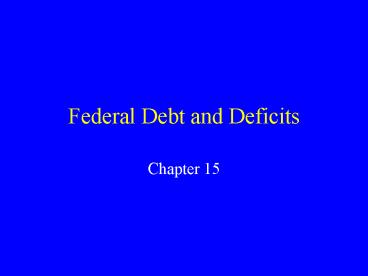Federal Debt and Deficits - PowerPoint PPT Presentation
1 / 17
Title:
Federal Debt and Deficits
Description:
Capital budgeting sale of asset reduces deficit under current system but not ... Cyclically adjusted or full employment budget. The cyclical contribution to the ... – PowerPoint PPT presentation
Number of Views:53
Avg rating:3.0/5.0
Title: Federal Debt and Deficits
1
Federal Debt and Deficits
- Chapter 15
2
Indebtedness of the Worlds Governments
3
Ratio of U.S. govt debt to GDP
1.2
1
0.8
0.6
0.4
0.2
0
1791
1815
1839
1863
1887
1911
1935
1959
1983
2007
4
The Fiscal Future
- The U.S. population is aging.
- Health care costs are rising.
- Spending on entitlements like Social Security and
Medicare is growing. - Deficits and the debt are projected to
significantly increase
5
Percent of U.S. population age 65
23
Percent of pop.
actual
projected
20
17
14
11
8
5
1950
1960
1970
1980
1990
2000
2010
2020
2030
2040
2050
6
U.S. government spending on Medicare and Social
Security
Percent of GDP
7
CBO projected U.S. federal govt debt in two
scenarios
300
250
200
Percent of GDP
150
100
50
0
2005
2010
2015
2020
2025
2030
2035
2040
2045
2050
8
Measurement Problems
- Inflation to keep real debt constant, debt must
grow by - ?D/D ?
- or
- ?D ?D
- Put differently, part of government expenditure
is interest on debt, which includes inflation
component - iD rD ?D
- Thus, deficit overstated by ?D
9
MEASUREMENT PROBLEM - Inflation
- Correcting the deficit for inflation can make a
huge difference, especially when inflation is
high. - Example In 1979,
- nominal deficit 28 billion
- inflation 8.6
- debt 495 billion
- ? D 0.086 ? 495b 43b
- real deficit 28b ? 43b 15b surplus
10
Capital Assets, Potential Liabilities and
Business Cycles
- Capital budgeting sale of asset reduces deficit
under current system but not with capital
budgeting - Problem which expenditures are capital and how
valued? - Unfunded obligations Social Security, Medicare
- Guaranteed securities contingent liability
- Fannie, Freddie, etc.
- Automatic stabilizers
- Cyclically adjusted or full employment budget
11
The cyclical contribution to the U.S. Federal
budget
12
Traditional view of debt
- For growth increase in deficit that increases D
crowds out I - reduces growth in short run and
long-run living standards - In short run, fiscal expansion increases demand
out put increases temporarily, prices increase in
long run - Global effect reduction in national saving
leads to capital inflow reduces crowding out of
investment, but exchange rate appreciation crowds
out exports
13
Ricardian Equivalence
- Current borrowing implies future taxes so
saving increase as long as agents care about
future generations - However, individuals may not think about future
(myopia), or may be liquidity constrained
(borrowing constraints) so shift of taxes to
future allows increases consumption today - What is motive for bequests?
- Strategic bequest motive children visit more
- Residual bequests due to uncertainty
- Reagan tax cuts crowded out exports not
equivalence
14
Balanced Budget vs. Optimal Fiscal Policy
- Balance budget every year
- Optimal policy
- Smooth taxes
- Stabilize output
- Redistribute income across generations if
justified
15
Other issues
- Do debt and deficits affect monetary policy?
- Debt shifts burdens to future taxpayers who are
not represented argues for balanced budget - High level of debt may cause trade deficits
and/or encourage capital flight - International lender status may increase global
influence but debtor status has not hurt U.S.
16
CASE STUDYInflation-indexed Treasury bonds
- Starting in 1997, the U.S. Treasury issued bonds
with returns indexed to the CPI. - Benefits
- Removes inflation risk, the risk that inflation
and hence real interest rate will turn out
different than expected. - May encourage private sector to issue
inflation-adjusted bonds. - Provides a way to infer the expected rate of
inflation
17
CASE STUDYInflation-indexed Treasury bonds
6
5
4
percent (annual rate)
3
2
1
0
2003-
2003-
2003-
2004-
2004-
2005-
2005-
2006-
01-03
06-27
12-19
06-11
12-03
05-27
11-18
05-12






























